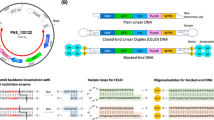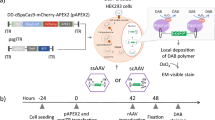Abstract
Silencing of gene expression by small interfering RNAs (siRNAs) is rapidly becoming a powerful tool for genetic analysis of mammalian cells. The use of DNA-based plasmid vectors to achieve transient and stable expression of siRNA has been developed to avoid the problems of double-stranded oligonucleotides transfection. These vectors direct the transcription of small hairpin RNAs (shRNAs) from a polymerase-III (H1 or U6)-RNA gene promoter. However, numerous disadvantages remain, including low transfection efficiency and difficulty in transfecting primary cells. To overcome some of these problems, the use of viral vectors for siRNA delivery has been described. Retroviral, adenoviral, adeno-associated and herpes viral shRNAs delivery systems have been successfully used to silence genes, in vitro and in vivo. The use of a herpes simplex virus type 1 (HSV-1)-based amplicon vector for siRNA delivery into mammalian cells, using human polyomavirus BK (BKV)-transformed cells as a model system is described. The results demonstrate the ability of amplicon vectors to inhibit the expression of BKV T-Ag and tumorigenicity of BKV-transformed cells. We show that the use of the amplicon vector is highly efficient for the delivery of siRNA molecules. The unique ability of these vectors to deliver multiple copies of siRNA may provide a useful tool in the development of novel anticancer therapy.
This is a preview of subscription content, access via your institution
Access options
Subscribe to this journal
Receive 12 print issues and online access
$259.00 per year
only $21.58 per issue
Buy this article
- Purchase on Springer Link
- Instant access to full article PDF
Prices may be subject to local taxes which are calculated during checkout




Similar content being viewed by others
References
Gong H, Liu CM, Liu DP, Liang CC . The role of small RNAs in human diseases: potential troublemaker and therapeutic tools. Med Res Rev 2005; 25: 361–381.
Leung RK, Whittaker PA . RNA interference: from gene silencing to gene-specific therapeutics. Pharmacol Ther 2005; 107: 222–239.
Izquierdo M . Short interfering RNAs as a tool for cancer gene therapy. Cancer Gene Ther 2005; 12: 217–227.
Li M, Rossi JJ . Lentiviral vector delivery of siRNA and shRNA encoding genes into cultured and primary hematopoietic cells. Methods Mol Biol 2005; 309: 261–272.
Devroe E, Silver PA . Therapeutic potential of retroviral RNAi vectors. Expert Opin Biol Ther 2004; 4: 319–327.
Taulli R, Accornero P, Follenzi A, Mangano T, Morotti A, Scuoppo C et al. RNAi technology and lentiviral delivery as a powerful tool to suppress Tpr-Met-mediated tumorigenesis. Cancer Gene Ther 2005; 12: 456–463.
Tomar RS, Matta H, Chaudhary PM . Use of adeno-associated viral vector for delivery of small interfering RNA. Oncogene 2003; 22: 5712–5715.
Xu D, McCarty D, Fernandes A, Fisher M, Samulski RJ, Juliano RL . Delivery of MDR1 small interfering RNA by self-complementary recombinant adeno-associated virus vector. Mol Ther 2005; 11: 523–530.
Tomanin R, Scarpa M . Why do we need new gene therapy viral vectors? Characteristics, limitations and future perspectives of viral vector transduction. Curr Gene Ther 2004; 4: 357–372.
Sumimoto H, Yamagata S, Shimizu A, Miyoshi H, Mizuguchi H, Hayakawa T et al. Gene therapy for human small-cell lung carcinoma by inactivation of Skp-2 with virally mediated RNA interference. Gene Ther 2005; 12: 95–100.
Epstein AL, Marconi P, Argnani R, Manservigi R . HSV-1 derived recombinant and amplicon vectors for gene transfer and gene therapy. Curr Gene Ther 2005; 5: 445–448.
Goins WF, Wolfe D, Krisky DM, Bai Q, Burton EA, Fink DJ et al. Delivery using herpes simplex virus: an overview. Methods Mol Biol 2004; 246: 257–299.
Lachmann R . Herpes simplex virus-based vectors. Int J Exp Pathol 2004; 85: 177–190.
Saydam O, Glauser DL, Heid I, Turkeri G, Hilbe M, Jacobs AH et al. Herpes simplex virus 1 amplicon vector-mediated siRNA targeting epidermal growth factor receptor inhibits growth of human glioma cells in vivo. Mol Ther 2005; 12: 803–812.
Oehmig A, Fraefel C, Breakefield XO, Ackermann M . Herpes simplex virus type 1 amplicons and their hybrid virus partners, EBV, AAV, and retrovirus. Curr Gene Ther 2004; 4: 385–408.
Portolani M, Barbanti-Brodano G, Placa ML . Malignant transformation of hamster kidney cells by BK virus. J Virol 1975; 15: 420–422.
Grossi MP, Caputo A, Meneguzzi G, Corallini A, Carra L, Portolani M et al. Transformation of human embryonic fibroblasts by BK virus, BK virus DNA and a subgenomic BK virus DNA fragment. J Gen Virol 1982; 63: 393–403.
Portolani M, Borgatti M . Stable transformation of mouse, rabbit and monkey cells and abortive transformation of human cells by BK virus, a human papovavirus. J Gen Virol 1978; 38: 369–374.
Corallini A, Altavilla G, Cecchetti MG, Fabris G, Grossi MP, Balboni PG et al. Ependymomas, malignant tumors of pancreatic islets, and osteosarcomas induced in hamsters by BK virus, a human papovavirus. J Natl Cancer Inst 1978; 61: 875–883.
Tognon M, Corallini A, Martini F, Negrini M, Barbanti-Brodano G . Oncogenic transformation by BK virus and association with human tumors. Oncogene 2003; 22: 5192–5200.
Zhu JY, Abate M, Rice PW, Cole CN . The ability of simian virus 40 large T antigen to immortalize primary mouse embryo fibroblasts cosegregates with its ability to bind to p53. J Virol 1991; 65: 6872–6880.
Negrini M, Castagnoli A, Pavan JV, Sabbioni S, Araujo D, Corallini A et al. Suppression of tumorigenicity and anchorage-independent growth of BK virus-transformed mouse cells by human chromosome 11. Cancer Res 1992; 52: 1297–1303.
Osborn M, Weber K . Simian virus 40 gene A function and maintenance of transformation. J Virol 1975; 15: 636–644.
Sabbioni S, Callegari E, Spizzo R, Veronese A, Altavilla G, Corallini A et al. Anticancer activity of an adenoviral vector expressing short hairpin RNA against BK virus T-ag. Cancer Gene Ther, accepted for publication.
Saeki Y, Fraefel C, Ichikawa T, Breakefield XO, Chiocca EA . Improved helper virus-free packaging system for HSV amplicon vectors using an ICP27-deleted, oversized HSV-1 DNA in a bacterial artificial chromosome. Mol Ther 2001; 3: 591–601.
Lowenstein PR, Fournel S, Bain D, Tomasec P, Clissold P, Castro MG et al. Herpes simplex virus 1 (HSV-1) helper co-infection affects the distribution of an amplicon encoded protein in glia. Neuroreport 1994; 5: 1625–1630.
Grandi P, Wang S, Schuback D, Krasnykh V, Spear M, Curiel DT et al. HSV-1 virions engineered for specific binding to cell surface receptors. Mol Ther 2004; 9: 419–427.
Zhou G, Roizman B . Characterization of a recombinant herpes simplex virus 1 designed to enter cells via the IL13Ralpha2 receptor of malignant glioma cells. J Virol 2005; 79: 5272–5277.
Acknowledgements
This work was supported by grants from the Italian Association for Cancer Research (AIRC), the Italian National Institute of Health (ISS), EU Research Grant THOVLEN and by Ministero dell'Istruzione, Università e Ricerca scientifica (MIUR, 40–60%). Our thanks to Dr Amanda J Neville for editorial support in improving English text.
Author information
Authors and Affiliations
Corresponding author
Rights and permissions
About this article
Cite this article
Sabbioni, S., Callegari, E., Manservigi, M. et al. Use of herpes simplex virus type 1-based amplicon vector for delivery of small interfering RNA. Gene Ther 14, 459–464 (2007). https://doi.org/10.1038/sj.gt.3302878
Received:
Revised:
Accepted:
Published:
Issue Date:
DOI: https://doi.org/10.1038/sj.gt.3302878



